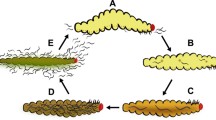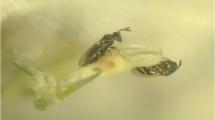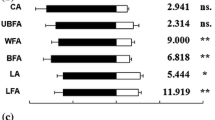Abstract
Volatile infochemicals play a significant role in the interactions between trophic levels. Volatile infochemicals may allow species within the third trophic level to avoid patches where conspecifics or heterospecifics are present. We show odor-mediated resource assessment by entomopathogenic nematodes in the family Steinernematidae. We hypothesized that the infective juvenile nematodes may reduce inter- and intraspecific competition by responding differently to unparasitized hosts vs. hosts parasitized by conspecific or heterospecific nematodes. All Steinernema spp. except S. carpocapsae were attracted to hosts that were not parasitized. Steinernema carpocapsae infective juveniles were repelled from hosts infected for 4 hr with all heterospecific infections except S. anomaliwhereas S. glaseri were repelled only from S. riobravis-infected hosts. Steinernema feltiae did not differentiate any heterospecific or heterogeneric infections. Steinernema glaseri were attracted to four of five heterospecific infections and S. anomali and S. riobravis were attracted to two of five heterospecific infections. Both S. anomali and S. glaseri were more attracted to hosts infected with the out-group Heterorhabditis bacteriophora than those infected by conspecific nematodes. Infective juvenile S. carpocapsae S. anomaliand S. glaseri were more attracted to insects colonized by conspecific nematodes than to uninfested insects. Infective juvenile S. carpocapsae were repelled from the 24-hr-old conspecific infections, whereas S. glaseri were less attracted to 24- than to 4-hr-old conspecific infections. Experiments with insects injected with bacteria from the nematodes suggested the latter as the source of active volatiles. We suggest that odor-mediated host recognition by infective juveniles may reduce inter- and intraspecific competition among Steinernematidae.
Similar content being viewed by others
REFERENCES
AKHURSTR. J. 1980. Morphological and functional dimorphism in Xenorhabdus spp., bacteria symbiotically associated with insect pathogenic nematodes Neoaplectana and Heterorhabditis. J. Gen. Microbiol. 121:303–309.
AKHURSTR. J. 1993. Bacterial symbionts of entomopathogenic nematodes—the power behind the throne, pp. 127–135in R. Bedding, R. Akhurst, and H. K. Kaya (eds.). Nematodes and the Biological Control of Insect Pests. CSIRO Publications, East Melbourne, Australia.
AKHURSTR. J., and BEDDINGR. A. 1986. Natural occurrence of insect pathogenic nematodes (Steinernematidae and Heterorhabditidae) in soil in Australia. J. Aust. Entomol. Soc. 25:241–244.
AKHURSTR. J., and BROOKSW. M. 1984. The distribution of entomophilic nematodes (Heterorhabditidae and Steinernematidiae) in North Carolina. J. Invertebr. Pathol. 44:140–145.
AKHURSTR. J.BEDDINGR. A.BULLR. M., and SMITHD. R. J. 1992. An epizootic of Heterorhabditis spp. (Heterorhabditidae: Nematoda) in sugar cane Scarabaeids (Coleoptera). Fundam. Appl. Nematol. 15:71–73.
ANONYMOUS. 1987. SAS User's Guide: Statistics. SAS Institute, Cary, North Carolina.
BEAVERSJ. B.MC COYC. W., and KAPLAND. T. 1983. Natural enemies of subterranean Diaprepes abbreviatus (Coleoptera: Curculionidae) larvae in Florida. Environ. Entomol. 12:840–843.
BELLW. J. 1991. Searching Behaviour: The Behavioral Ecology of Finding Resources. Chapman and Hall Animal Behavior Series, London.
BOEMAREN. E.AKHURSTR. J., and MOURANTR. G. 1993. DNA relatedness between Xenorhabdus spp. (Enterobacteriacae) symbiotic bacteria of entomopathogenic nematodes, and a proposal to transfer Xenorhabdus luminescens to a new genusPhotorhabdus gen. nov. Int. Syst. Bacteriol. 43:249–255.
CAMPBELLJ. F., and GAUGLERR. 1993. Nictation behaviour and its ecological implications in the host search strategies of entomopathogenic nematodes (Heterorhabditidae and Steinernematidae). Behaviour 126:3–14.
CAMPBELLJ. F.LEWISE. E.YODERF., and GAUGLERR. 1995. Entomopathogenic nematode (Heterorhabditidae and Steninernematidae) seasonal population dynamics and impact on insect populations in turfgrass. Biol. Control. 5:598–606.
DUTKYS. R.THOMPSONJ. V., and CANTWELLG. E. 1964. A technique for the mass propagation of the DD-136 nematode. J. Insect Pathol. 6:417–422.
EHLERSR.-U.DESEOK. V., and STRACKEBRANDTE. 1991. Identification of Steinernema spp. (Nematoda) and their symbiotic bacteria Xenorhabdus spp. from Italian and German soils. Nematologica 37:360–366.
GREWALP. S., and WRIGHTD. J. 1991. Migration of Caenorhabditis elegans (Nematoda: Rhabditidae) larvae towards bacteria and the nature of bacterial stimulus. Fundam. Appl. Nematol. 15:159–166.
GREWALP. S.GAUGLERR., and LEWISE. E. 1993a. Host recognition behavior of entomopathogenic nematodes: During contact with gut contents. J. Parasitol. 79:495–503.
GREWALP. S.GAUGLERR., and SELVANS. 1993b. Host recognition by entomopathogenic nematodes: Behavioral response to contact with host feces. J. Chem. Ecol. 19:1219–1231.
GREWALP. S.SELVANS.LEWISE. E., and GAUGLERR., 1993c. Male insect-parasitic nematodes: A colonizing sex. Experientia 49:605–608.
GREWALP. S.LEWISE. E.GAUGLERR., and CAMPBELLJ. F. 1994a. Host finding behaviour as a predictor of foraging strategy in entomopathogenic nematodes. Parasitology 108:207–215.
GREWALP. S.SELVANS., and GAUGLERR. 1994b. Thermal adaptation of entomopathogenic nematodes: Niche breadth for infection, establishment, and reproduction. J. Therm. Bio. 19:245–253.
HUEYR. B., and PIANKAE. R. 1981. Ecological consequences of foraging mode. Ecology 52:991–999.
JANSSENA.VAN ALPHENJ. J. M.SABLESM. W., and BAKKERK. 1995. Specificity of odourmediated avoidance of competition in Drosophila parasitoids. Behav. Ecol. Sociobiol. 36:229–235.
KOPPENHOFFERA. H.KAYAH. K.SHANMUGANand WOODG. L. 1995. Interspecific competition between steinernematid nematodes within an insect host. J. Invertebr. Pathol. 66:99–103.
LEWISE. E.GAUGLERR., and HARRISONR. 1992. Entomopathogenic nematodes host finding: Response to host contact cues by cruise and ambush foragers. Parasitology 105:103–107.
LEWISE. E.GAUGLERR., and HARRISONR. 1993. Response of cruiser and ambusher entomopathogenic nematodes (Steinernematidae) to host volatile cues. Can. J. Zool. 71:765–769.
LEWISE. E.GREWALP. S., and GAUGLERR. 1995. Hierarchical order of host cues in parasite foraging strategies. Parasitology 110:207–213.
LEWISE. E.RICCIM., and GAUGLERR. 1996. Host recognition behaviour predicts host suitability in the entomopathogenic nematode Steinernema carpocapsae (Rhabditida: Steinernematidae). Parasitology. In press.
PATTERSONH. E. H. 1985. The recognition concept of species, pp. 21–29in E. S. Vrba (ed.). Species and Speciation. Transvaal Museum Monograph No. 4, Pretoria, South Africa.
POINARG. O.JR1979. Nematodes for Biological Control of Insects. CRC Press, Boca Raton, Florida.
PRICEP. W. 1984. Insect Ecology. John Wiley & Sons, London.
SELVANS.CAMPBELLJ. F., and GAUGLERR. 1993. Density-dependent effects on entomopathogenic nematodes (Heterorhabditidae and Steinernematidae) within an insect host. J. Invertebr. Pathol. 62:278–284.
STRANDM. R.JOHNSONJ. A., and CULLINJ. D. 1995. Intrinsic interspecific competition between the polyembryonic parasitoid Copidosoma floridanum and solitary endoparasitiod Microplitis demolitor in Pseudoplusia includens. Entomol. Exp. Appl. 55:275–284.
WOODRINGJ. L., and KAYAH. K. 1988. Steinernematid and Heterorhabditid Nematodes: A Handbook of Techniques. Southern Cooperative Series Bulletin 331, Arkansas Agricultural Experiment Station, Fayetteville, Arkansas.
ZERVOSS.JOHNSONS. C., and WEBSTERJ. M. 1991. Effects of temperature and inoculum size on reproduction and development of Heterorhabditis heliothidis and development of Heterorhabditis heliothidis and Steinernema glaseri (Nematoda: Rhabditida) in Galleria mellonella. Can. J. Zool. 69:1261–1264.
ZIONIS.GLAZERI., and SEGALD. 1992. Life cycle and reproductive potential of the nematode Heterorhabditis bacteriophora strain HP88. J. Nematol. 24:352–358.
Author information
Authors and Affiliations
Rights and permissions
About this article
Cite this article
Grewal, P.S., Lewis, E.E. & Gaugler, R. Response of Infective Stage Parasites (Nematoda: Steinernematidae) to Volatile Cues from Infected Hosts. J Chem Ecol 23, 503–515 (1997). https://doi.org/10.1023/B:JOEC.0000006374.95624.7e
Issue Date:
DOI: https://doi.org/10.1023/B:JOEC.0000006374.95624.7e




